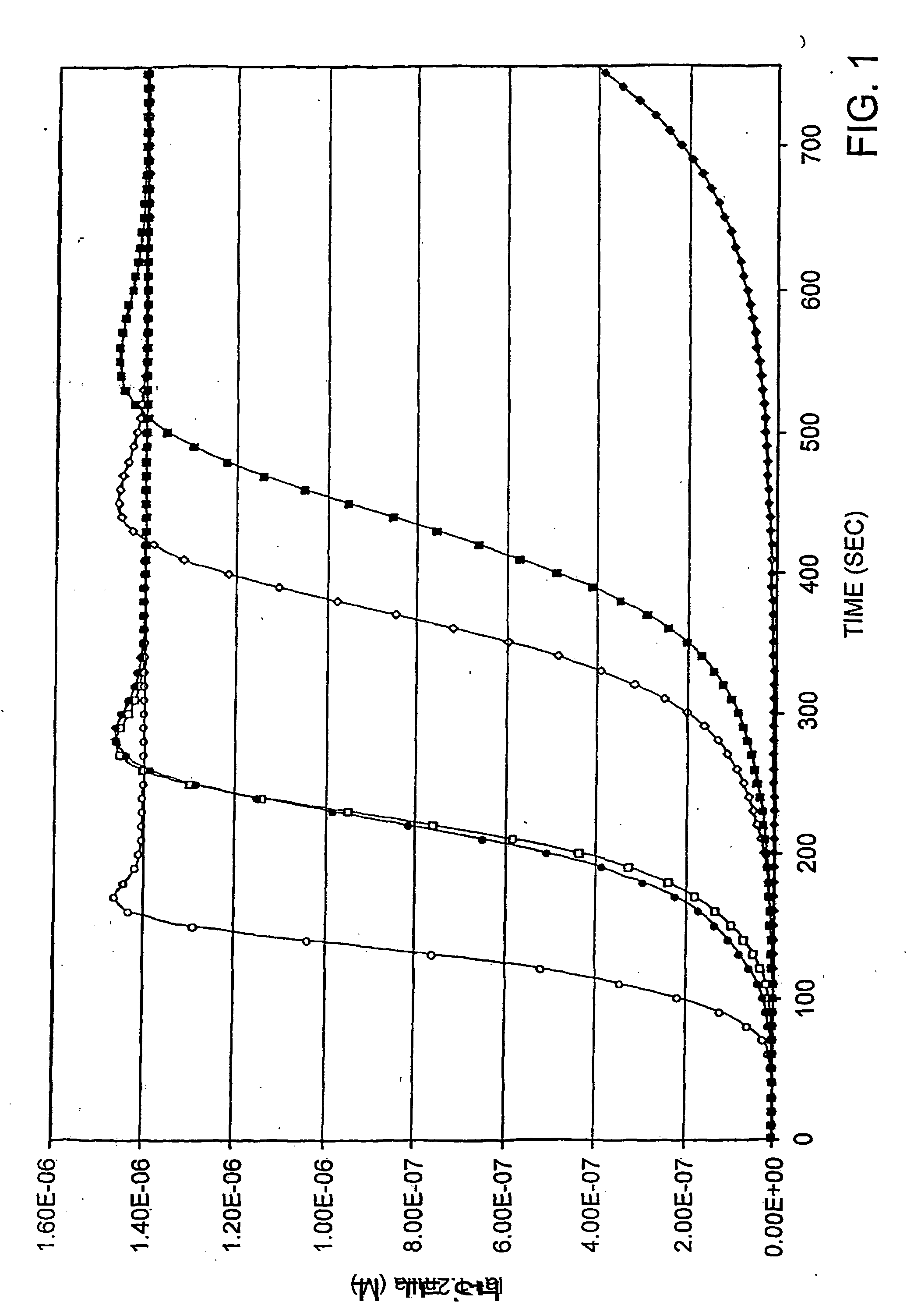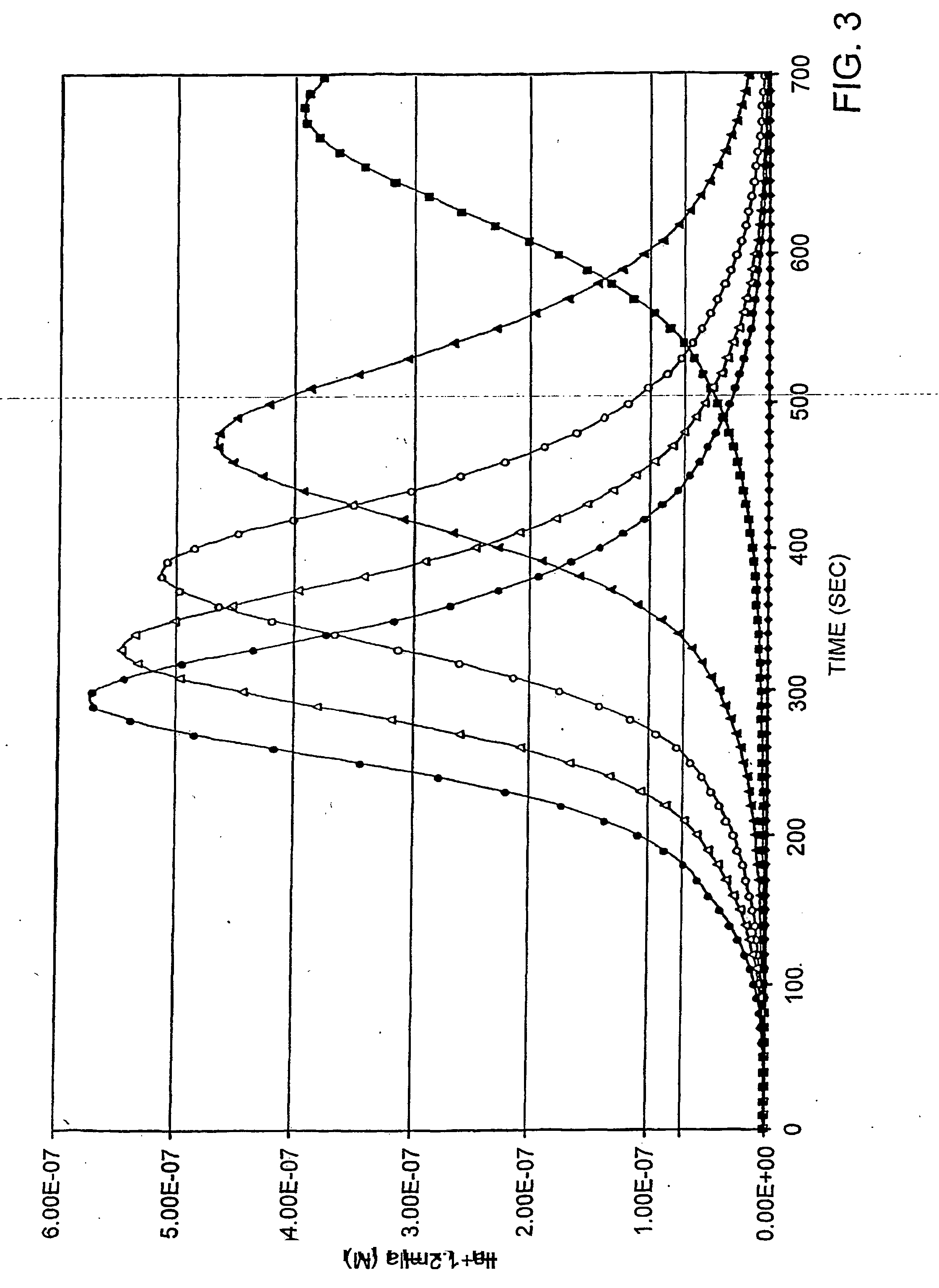Blood clotting predictor
a blood clotting predictor and mathematical model technology, applied in the field of blood coagulation, can solve the problems of unfavorable suffering or death, inability to fully understand the blood chemistry involved, and inability to complete mathematical models of blood coagulation, and achieve the effect of predicting the time it will take to function without empirical evidence, and avoiding suffering or death
- Summary
- Abstract
- Description
- Claims
- Application Information
AI Technical Summary
Problems solved by technology
Method used
Image
Examples
example 1
Analysis of Procoagulants in the Absence of Inhibition
[0161] Simulations (FIG. 1, open symbols) were performed in the context of only the procoagulation model (Table 1, #1-19). Increasing TF concentrations (1, 5, 25 pM) result in reduction of the duration of the initiation phase which is arbitrarily defined as the time from introduction of TF necessary to generate 20 nM thrombin. The concentration of thrombin is represented as the activity measured using the synthetic substrate S-2238. The “bump” observed prior to the stable final value (1.4×106 M) is a consequence of the 20% greater activity displayed toward this substrate by meizothrombin (Jones and Mann, 1994, J. Biol. Chem. 269, 23367-23373; Doyle and Mann, 1990, J. Biol. Chem. 265, 10693-10701). Over the range of TF illustrated in the absence of TFPI (open symbols) the maximum rate of thrombin production varied approximately five fold. In the present model the initial activation of prothrombin occurs; by factor Xa-membrane and...
example 2
Effect of the Combination of AT-III and TFPI on TF Initiated Thrombin Formation
[0165] The addition of AT-III to the procoagulant reaction requires rate equations for IIa, mIIa, factor Xa, factor IXa and TF-factor VIIa complexation with this inhibitor (Table 1, #23-27). When compared to the procoagulant-alone system, simulations including AT-III exhibit bell shaped curves for thrombin generation at all TF concentrations tested. When challenged with 25 pM TF in the presence of 3.4 μM
[0166] AT-III (FIG. 2 diamonds), thrombin production is slightly delayed, is at a maximum near 150. seconds, subsequently decreases and is nearly consumed by 400 seconds. Reactions with TFPI, in the absence of AT-III, 25 pM TF (triangles) yield maximal rates of thrombin production at ˜200 seconds and quantitative activation by 300 seconds. As observed in “wet” experiments AT-III does little to alter the duration of the initiation phase or the maximum rate of thrombin formation while TFPI (Table 1, #20-22...
example 4
Analysis of the Initiation Phase of the Procoagulant Response
[0170] Following complexation of factor VIIa with TF-PCPS (Table 1 # 2), the initiation phase begins with the activation of factor IX and factor X to their respective enzyme products (Table 1 #6, 8). As noted, the duration of this initiation phase is largely a consequence of factor VIIa and TF and regulation by factor VII and TFPI (Table 1 #1, 2, 21, 22). The factor Xa generated initially by the factor VIIa-TF complex (Table 1 # 6, 7) activates a small amount of prothrombin to thrombin (Table 1 # 9). That thrombin begins the process of catalyst building by activating factor V and factor VIII (Table 1 # 10, 16).
[0171] Although factor Xa-PCPS has the capacity to activate factor V (Foster, et al., 1983, J. Biol. Chem. 258, 13970-13977), empirical data (Butenas, et al., 1997, supra) shows conclusively that thrombin is the essential early activator in “wet” chemical experiments. Thus, crucial to the initiation phase is the ac...
PUM
 Login to View More
Login to View More Abstract
Description
Claims
Application Information
 Login to View More
Login to View More - R&D
- Intellectual Property
- Life Sciences
- Materials
- Tech Scout
- Unparalleled Data Quality
- Higher Quality Content
- 60% Fewer Hallucinations
Browse by: Latest US Patents, China's latest patents, Technical Efficacy Thesaurus, Application Domain, Technology Topic, Popular Technical Reports.
© 2025 PatSnap. All rights reserved.Legal|Privacy policy|Modern Slavery Act Transparency Statement|Sitemap|About US| Contact US: help@patsnap.com



